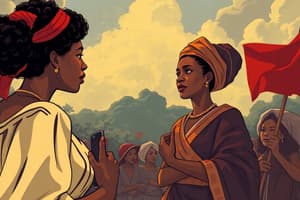Podcast
Questions and Answers
What was the main focus of the Women's Movement in the early 1800s?
What was the main focus of the Women's Movement in the early 1800s?
- Women's right to vote
- Women's participation in the workforce
- Women's role as mothers and caretakers of the home (correct)
- Women's access to education
Who were the leaders of the Women's Movement that held the Seneca Falls convention?
Who were the leaders of the Women's Movement that held the Seneca Falls convention?
Lucretia Mott and Elizabeth Cady Stanton
The Abolitionist Movement aimed to end _____ in America.
The Abolitionist Movement aimed to end _____ in America.
slavery
Frederick Douglass and Harriet Tubman were both advocates for the Abolitionist Movement.
Frederick Douglass and Harriet Tubman were both advocates for the Abolitionist Movement.
Who campaigned for better conditions for the mentally ill?
Who campaigned for better conditions for the mentally ill?
Which religious revival occurred from the 1800s to the 1840s?
Which religious revival occurred from the 1800s to the 1840s?
The Education Reform movement aimed to reduce poverty by getting children into _____ schools.
The Education Reform movement aimed to reduce poverty by getting children into _____ schools.
Who is credited with creating public schools in the Education Reform movement?
Who is credited with creating public schools in the Education Reform movement?
Which group was concerned with spiritualism and intellectualism during the 1800s?
Which group was concerned with spiritualism and intellectualism during the 1800s?
The Temperance Movement was fully successful in establishing prohibition.
The Temperance Movement was fully successful in establishing prohibition.
Match the following reformers with their contributions:
Match the following reformers with their contributions:
Flashcards are hidden until you start studying
Study Notes
Women's Movement
- Post-American Revolution, women were primarily seen as caregivers, adhering to the Cult of Domesticity.
- Discontent with societal roles grew, paralleling the abolitionist movement's struggle for equality.
- Key figures like Lucretia Mott and Elizabeth Cady Stanton organized the Seneca Falls Convention.
- The Declaration of Sentiments was a pivotal document drafted at this convention, calling for women's rights.
Abolitionist Movement
- Aimed to eradicate slavery in the United States, heavily influenced by the Second Great Awakening.
- Notable initiatives included the Underground Railroad, aiding enslaved people in their escape.
- Frederick Douglass and Harriet Tubman emerged as prominent advocates, both having escaped slavery.
Prison Reform
- Dorothea Dix led a national campaign to improve conditions for the mentally ill.
- She visited various institutions to highlight poor treatment, advocating for humane care and better facilities.
Second Great Awakening
- A religious revival that spanned from the 1800s to the 1840s, reigniting Protestant beliefs.
- Influential preacher Charles Finney played a crucial role in spreading these ideas.
Education Reform
- Focused on expanding access to public education as a means to alleviate poverty.
- Key leaders included Horace Mann, who established public schools, Noah Webster, who produced an influential dictionary, and William McGuffey, who authored foundational school books.
Transcendentalism
- Reformers emphasized spiritual and intellectual growth, reacting against materialism.
- The Hudson River School, a group of artists, celebrated American landscapes through romanticism.
- Prominent works include Henry David Thoreau's "Civil Disobedience" and Ralph Waldo Emerson's "Self-Reliance," reflecting transcendentalist ideals.
Temperance Movement
- Advocated against alcohol consumption, aiming to eliminate its negative impact on society.
- Leaders like Bishop James Cannon and Mary Hunt championed the cause, achieving some successes, including the establishment of Prohibition through the 18th Amendment, which was later repealed by the 21st Amendment.
Studying That Suits You
Use AI to generate personalized quizzes and flashcards to suit your learning preferences.




